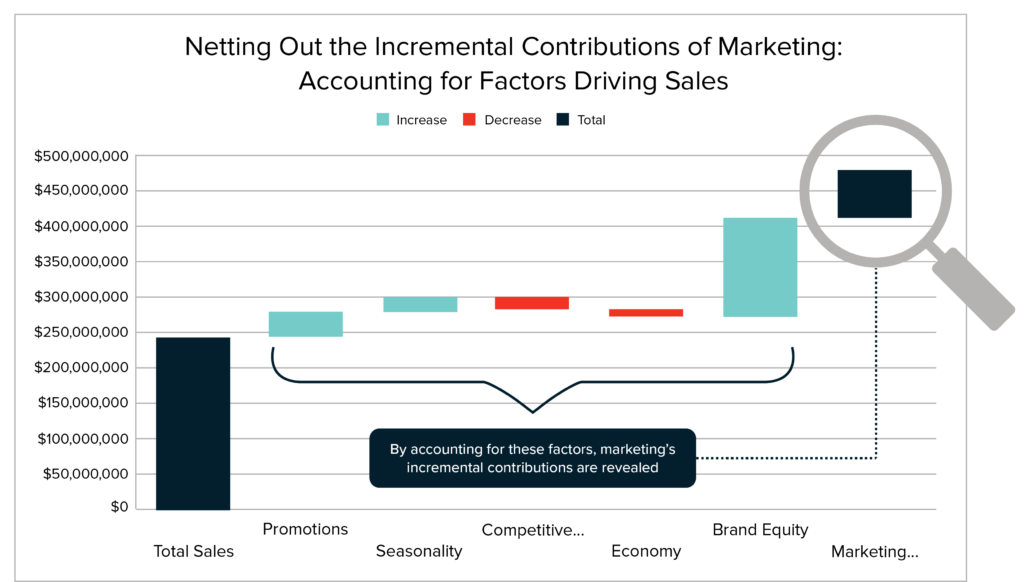What Kinds of Questions Can Marketing Attribution Answer?
04/28/2023

Brands use marketing attribution for a variety of reasons, but the main purpose has always been to determine how their marketing tactics have contributed to sales, conversions, or other business goals. However, the loss of tracking data has completely changed the marketing attribution game, and has forced this type of marketing measurement to evolve into something entirely different. As a result, the types of business questions that can be addressed by attribution have evolved too.
Marketing attribution isn’t just some “magical path to purchase” anymore (well truly, it never was). So, before we can dive into what questions can and cannot be answered by attribution, we must first re-define marketing attribution for today’s environment.
Re-Defining Marketing Attribution for Today’s Environment
Yesterday’s Multi-Touch Attribution (MTA) approach that attempted to track every user/ad/device on a path is no longer possible nor reliably accurate anymore due to the constant stream of new privacy changes and regulations that now protect the privacy of the consumer and reduce the available tracking date for attribution. Because of this, marketing attribution has been redefined to focus on measuring the incremental contribution of marketing efforts. This pivots marketing attribution away from trying to track every individual user and focuses on differentiating what an ad truly generates revenue-wise from what sales would have been obtained anyway (without the ad).
What Questions Can No Longer Reliably be Answered by Attribution

1. Path to Purchase
It is very tempting for marketers to believe that advertising can be reduced down to an equation of ad exposures and sequences, and that by unlocking this secret formula, marketing glory and career success will follow.
AD1 + AD2 + ADn = Massive Conversion Lift ⮕ Glory, Promotion!
Marketers have expended vast efforts to make the dream a reality. But just consider some of the basic building blocks that are required to pull off this type of marketing attribution to see why so many MTA efforts have failed:
- Third-party identity graphs
- The brand’s consumer data (PII) from CRM system
- Server:server integration for identity matching with 3rd party platforms
- MTA vendor/solution
- Web development team: deploy MTA pixels, tracking code, javascript, etc.
- Identity data from mobile devices
Also, there’s a common misperception that an MTA solution is “done” once the tracking code is in place. In fact, the solution isn’t even close to being done. Data must be collected over time to produce the first measures.
So… that “magical path to purchase”? Yeah, it doesn’t exist anymore (and marketers could never really control the path in the first place)…
2. Consumer-Level Measures
Even with digital advertising, it isn’t possible for a brand to know every ad that a consumer has seen across all of their devices. Traditional advertising in TV, radio, print and OOH have always had this struggle, but with the advent of digital tracking, marketers have invested huge amounts in technologies and 3rd party data sources to pursue this tracking dream. For most brands that have a complex mix of digital and traditional advertising, and many different conversion touchpoints, data match rates are a significant hurdle.
In the simplest case where a brand spends all of their advertising budget in Facebook and Google, match rates can be a bit better especially if the brand shares its customer database with the walled gardens. Why a brand would entrust their entire customer file with one of these players is an entirely separate (but excellent) question. But most brands execute their marketing across a much broader array of partners, channels, publishers and networks. And no single marketing campaign works in a vacuum. Cross-channel effects from one campaign and channel impact campaigns in other channels. Given these cross-channel effects and gaps in the ability to map ads, consumers and devices create a major degradation of marketing measurement.
3. App / Device Level Tracking Measures
Early on, the market and the analyst community was too prescriptive in terms of how the marketing attribution was to be accomplished, as opposed to focusing on the marketing objectives to be achieved by marketing attribution. This “marketing attribution = tracking consumers across their devices and ads” has done a real disservice to marketers because it has led them down a path of frustration, wasted time and effort and significant costs.
Plus, privacy changes from Apple and upcoming changes from Google are causing app/device-level tracking to go dark. Traditional attribution solutions are missing a significant amount of data now, throwing a wrench into the models’ accuracy.
While focusing on how attribution must be achieved, the most important reasons to do marketing attribution have been lost:
- Measure the incremental contribution of marketing
- Deliver tactical, rapid reads of performance at campaign levels
- Provide guidance to the marketer on short term performance lift and optimization opportunities
Nowhere in the above objectives does it say how attribution is to be accomplished, and why should it? If a better methodology exists to meet these objectives and it doesn’t suffer from all of the pitfalls and PII risks, it is still attribution, and a better way at that. Marketers have been sold down a very specific path of attribution, and it is time to take a better path.
4. What Combination and Sequence of Ads Drives the Highest Performance
Let’s pretend for a moment, that the sequence of ads across channels and devices mattered. And let’s also pretend that we could determine which ad was seen by a customer with high reliability. Finally, let’s pretend that by knowing all of this, we can assign an accurate value for each ad’s incremental contribution to sales.
Example: we know that a video ad on a mobile device that is 3rd in a sequence of 8 ads across TV, search, social and video contributes 17% to conversions. Great! So, what is a brand going to do with that knowledge?
Will the brand somehow convince the consumer to see the video ad 3rd in an 8 ad sequence? Can a brand ensure that the customer sees their video relative to their other channels’ campaigns– at a consumer AND device level? Will the brand somehow convince Facebook to wait for their ad to be served after Google gets to go first? Come on.
The myth that brands can control the sequence of ads– and know the exact combination or sequence of ads that drives the highest performance– is really the most damaging misperception about marketing attribution today. Not only is it not possible, but pursuing this myth creates a whole host of complexities and costs— all for what exactly?
Questions that Can Be Answered

1. Incremental Value of Digital Marketing Campaigns
Too many marketing attribution solutions mis-allocate credit for campaigns because they fail to account for some of the most fundamental sales drivers. Does a retailer’s sales increase every year during the period between Thanksgiving and Christmas because of advertising? No. Seasonality– in this case, holiday seasonal lift– drives a major part of the increase in sales. And if your attribution model fails to account for this, the measurement of a campaign’s contribution is likely to be highly inaccurate. However, with some of today’s marketing attribution solutions, the incremental value of digital marketing campaigns is a question that can be answered.

2. How do ads impact key KPIs
Your attribution solution should be able to measure the incremental marketing impacts on e-commerce sales– that’s the easy part. But what about offline conversions? In-store? In a bank branch? In a call center? Or, conversions via a sales team? How about conversions in mobile apps now that Apple doesn’t share IDs? And how about mobile– or any traffic coming through Google Chrome when individual user identities will no longer be available later in 2023? This is where things get difficult, and also where choosing the right vendor solution makes all the difference. Why would you deploy a solution that only answers a small part of your business conversions when you could choose a solution that covers them all?
3. Value of Programmatic Advertising– Are Ads Served to Certain Audiences Effective
The promise of programmatic is all about targeting and efficiency. By targeting only those customer segments that fit the business, wasted ad spend can be reduced. But do you need an MTA solution to measure whether you’ve reached those audiences or not? Absolutely not– that’s using a wrench for the job of a screwdriver. But, your attribution solution should be able to measure whether programmatic ads are effective at driving incremental revenue, and the solution should be able to show how these campaigns perform by audience or segment AND include ALL of the conversions driven– not just e-commerce ones. This total view of impact is essential for driving marketing success.
Bonus Questions Answered (If You Are Using the Right Marketing Attribution Solution)

Traditional Media
The right marketing attribution solution can measure any channel, campaign, or ad– digital and traditional, not just digital. In fact, a combination of the two is best with a complex set of channels and budget considerations. Why use a solution that only works for half (or less) of the picture?
Offline Conversions
With the right marketing attribution solution, you can measure how your digital ads impact real-world (offline) outcomes, such as purchases in your physical stores, phone orders, bookings, etc. Ads don’t live in a vacuum– digital ads have an effect on in-store and offline sales, so it is important to account for the full effect of digital ad investments. And with the right solution, you can.
Yield Curves, Saturation Levels and Optimal Investment Strategies
The right marketing attribution solution can estimate and measure media saturation and yield levels, which allows marketers the ability to pinpoint optimal investment levels. By running these real-time optimizations, marketers can move quickly to adjust in-market efforts and achieve better results.
What-If Scenario Planning
What-if scenario planning is a strategic planning tool that allows for the evaluation of any possible future states. The tool creates hypothetical views to help identify potential risks or opportunities. By using scenario planning, organizations, including marketing teams, can optimize their decisions, maximize budget impact, and drive better performance.
Examples of such software tools are OptiMine Inspire— a tactical toolset that allows marketers to evaluate in real-time the potential outcomes across different channel and campaign investment levels. OptiMine Inspire provides instant feedback on where the optimal level of investment is based on expected results at those investment levels— all by evaluating yield and saturation levels.
Optimized Budget Allocations
Some marketing attribution solutions also provide budget and media plan optimization capabilities. These optimization tools examine different investment levels across the entire marketing budget to create the most optimal allocation to achieve a goal or outcome. These optimization tools are beneficial because they allow marketers to make better financial decisions as well as make a case to their finance teams for specific investment approaches that will benefit the overall business.
For marketers looking for full budget scenario planning and optimization, OptiMine Intent provides a workbench tool to plan for future periods and evaluate different objectives and outcomes, and it delivers a fully detailed media plan and budget that is optimized to maximize the performance objective of the marketer. This type of scenario planning can be especially useful during periods of significant change— whether it be pandemic-driven, planning for a potential recession, or building out a ready-made playbook of options that can be instantly deployed given changing market conditions.
Impacts of Non-Marketing Factors
Sales in your stores spike on Saturdays during the holiday season. Does that mean the ads that ran on Saturday magically got more effective? Probably not. Using a marketing attribution solution that accounts for non-marketing factors such as the economy, competition, promotions, pricing discounts, and many other elements is critical to understanding how effective your marketing campaigns are. You’ll misstate the value of ads if you aren’t accounting for these elements.
The Right Marketing Attribution Solution is OptiMine

We hope by now that you have a better understanding for which questions marketing attribution can and cannot answer. There’s just one question left… what is the right marketing attribution solution for your brand?
OptiMine.
We’ll tell you why:
- Complete Coverage– only OptiMine measures both digital and traditional media in detail across all online and offline conversions to achieve a measure of the TOTAL impact of your marketing investments.
- Speed– OptiMine is the fastest solution in the market, with rapid implementation for fastest ramp to value
- Most actionable with granular detail– OptiMine provides the deepest, most granular measures for precise guidance and immediate action
- Privacy safe– OptiMine is 100% future-proof and completely unaffected by all current and future privacy changes and regulations because guess what? We use no PII, consumer tracking, or identity data. EVER.
OptiMine is the right marketing attribution solution for your brand, providing the fastest, most actionable cross-channel measurement for all digital and traditional marketing across any online and offline conversion points. Interested in learning more? Contact us today!
Check out some of our case studies below to learn how OptiMine has helped other brands like yours achieve marketing attribution success:

